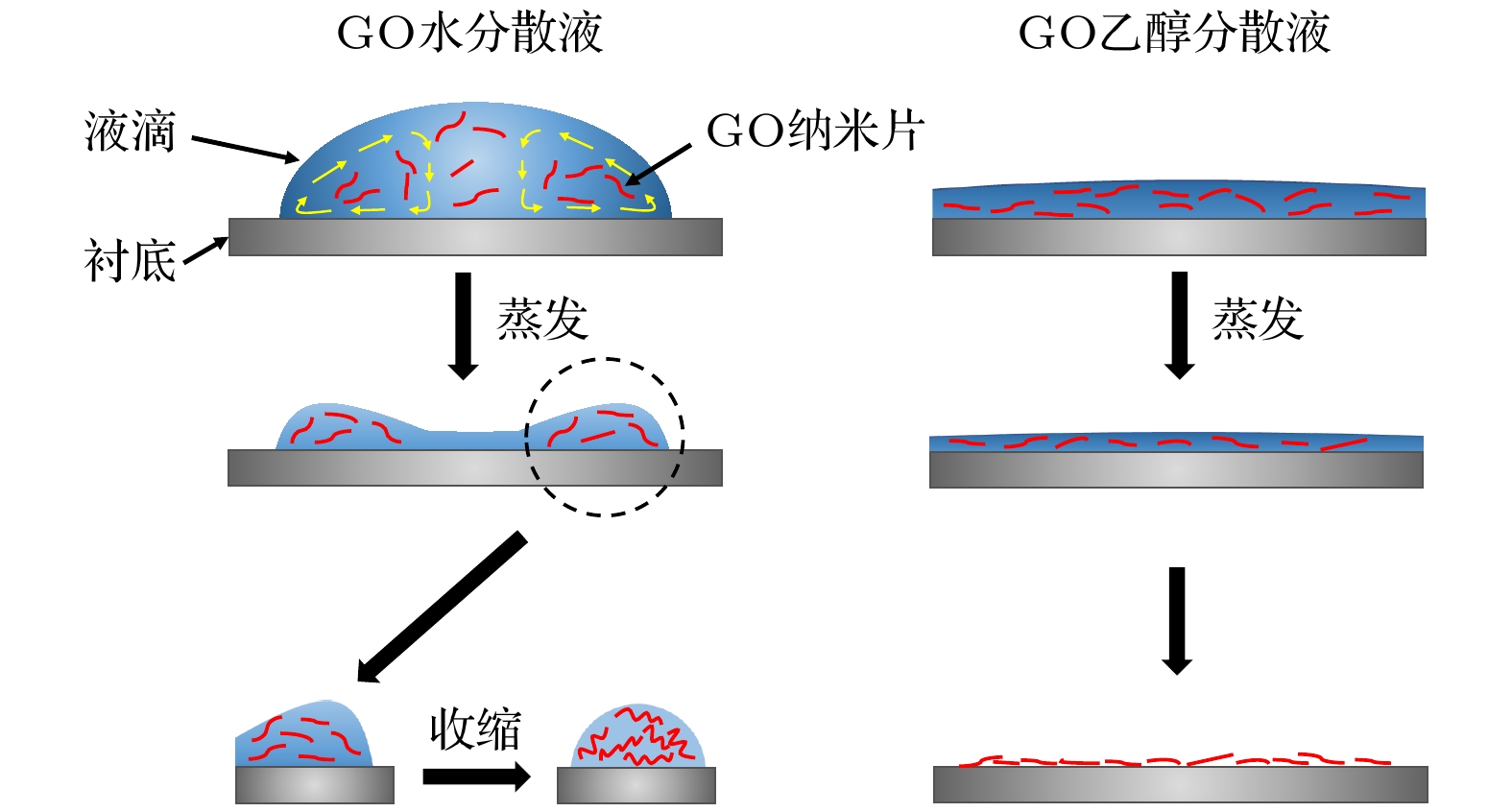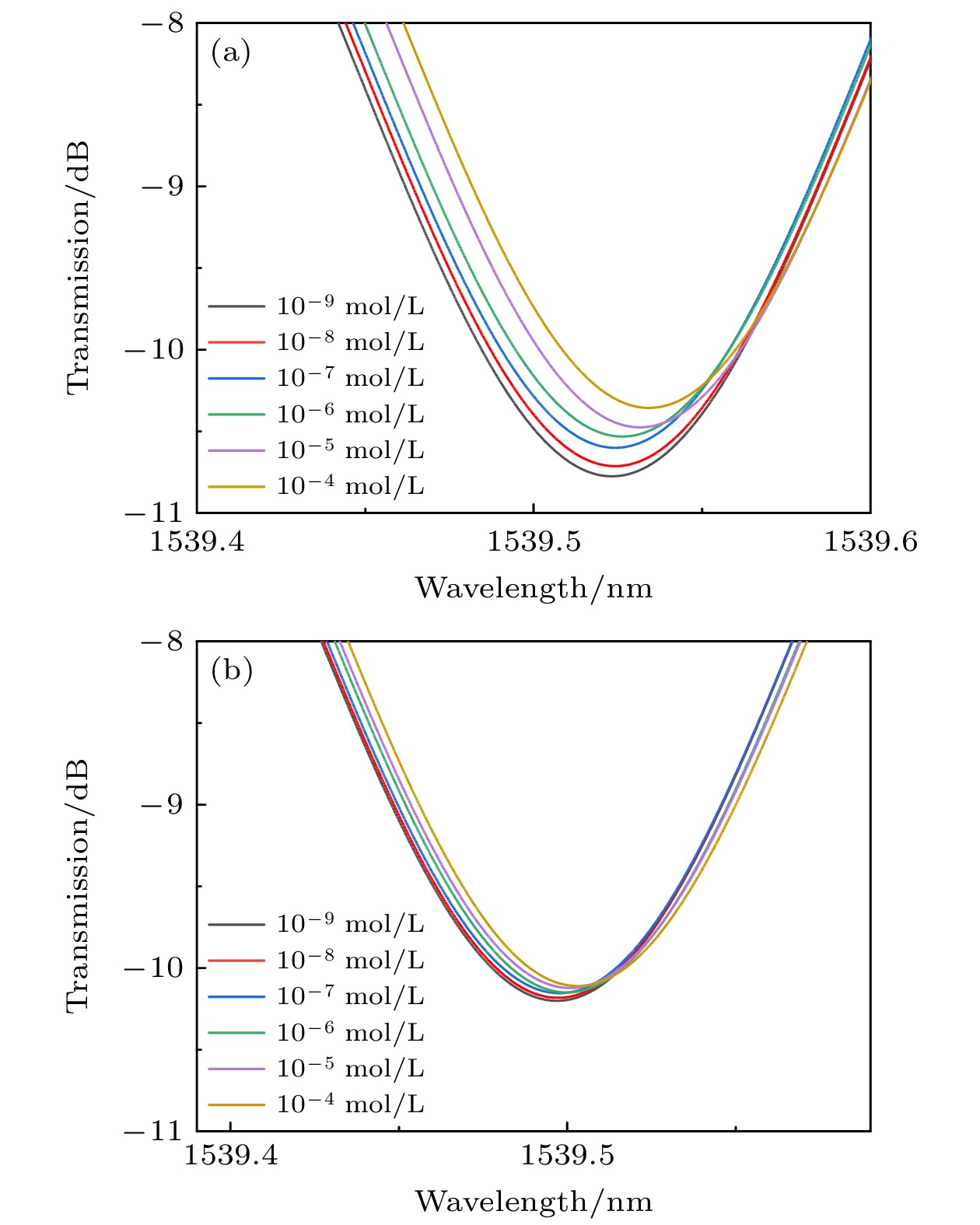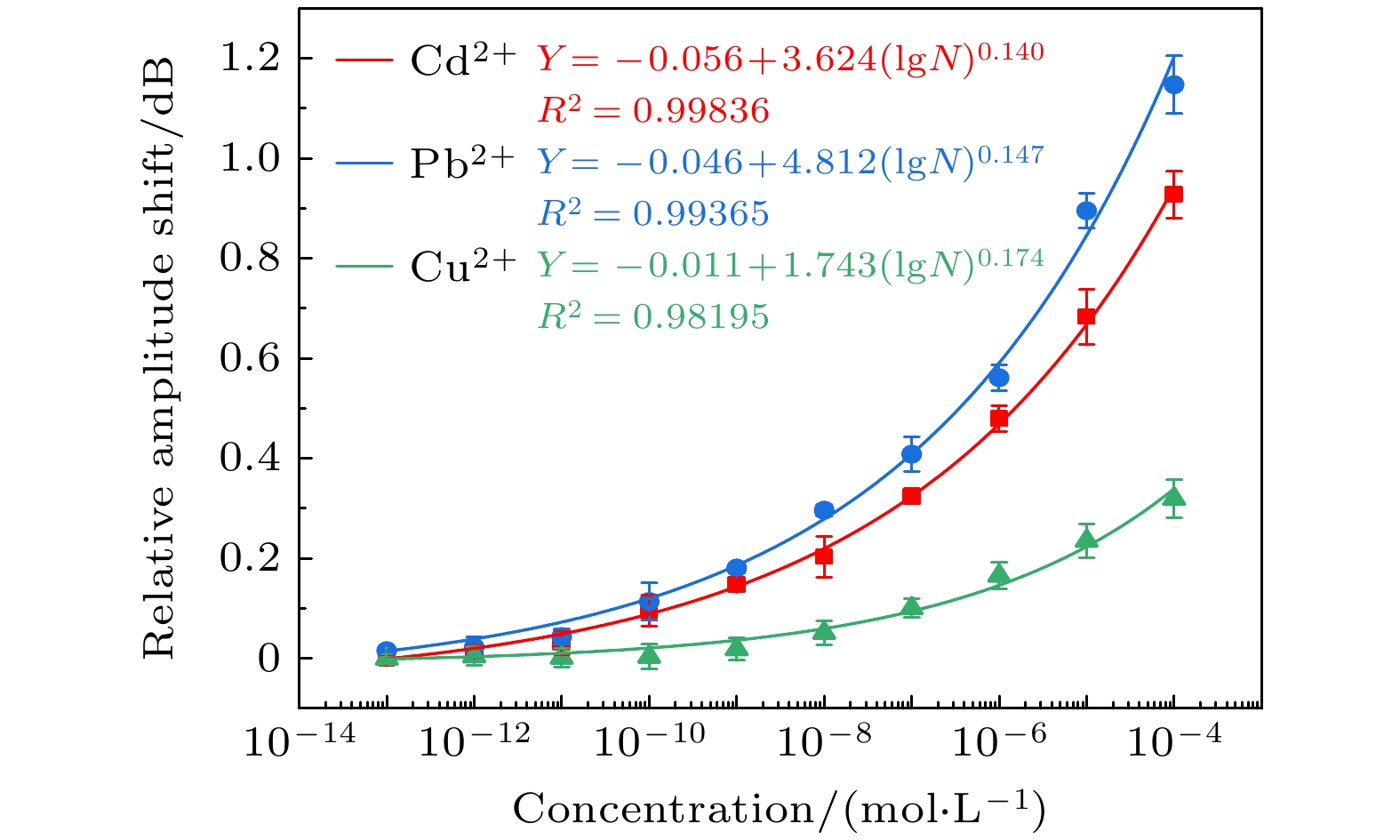-
设计了一种氧化石墨烯(GO)功能化的倾斜光纤光栅(TFBG)传感器, 用于检测水溶液中的重金属离子. 通过氧等离子体活化光纤表面, 以及采用GO的无水乙醇分散液, 避免了咖啡环效应引起的GO的团聚和堆叠, 充分了暴露GO的表面和羧基. 吸附重金属离子后, GO-TFBG传感器的透射光谱中的谐振峰发生红移, 这是由GO向重金属离子的电子转移导致的有效折射率变化造成的. 对Pb2+和Cd2+离子最低检测限可达到10–10 mol/L (ng/L量级), 相应灵敏度分别为0.426 dB/(nmol·L–1)和0.385 dB/(nmol·L–1)(2.06和3.43 dB/(μg·L–1)). 此外, GO-TFBG传感器具有出色的器件一致性, 5组传感器的传感性能稳定. 本研究实现了GO纳米片在光纤表面的无团聚和均匀成膜, 获得了具有超大表面积的GO并充分暴露表面羧基实现对重金属离子的吸附, 利用了TFBG不同模式谐振对环境的高度敏感性, 完成了对低浓度重金属离子的高灵敏度、可重复检测. 本研究为提高各种类型的基于二维材料的传感器性能提供了参考.Graphene oxide (GO) is an ideal label-free sensing material with its super large specific surface area and abundant surface functional groups. Considering its insulating characteristic, the GO is suitable for optics-based heavy metal ion sensing. However, given the large surface tension of water and the hydrophilicity of GO, the agglomeration or wrinkles of GO nanosheets is usually inevitable during coating with aqueous dispersion. This reduces the accessible surface area and surface functional groups of GO, thereby degrading the sensing performance. Here, an ultra-sensitive GO functionalized tilted fiber Bragg grating (TFBG) sensor is designed to detect heavy metal ions in aqueous solutions. Firstly, a strategy of free energy manipulation is employed to avoid the wrinkles and agglomeration of GO nanosheets. In the scenario of aqueous dispersion, the GO nanosheets will wrinkle as the water droplets evaporate and shrink. In contrast, using the lower-surface-tension ethanol as the dispersant and a high-surface-energy substrate processed by oxygen plasma, the dispersion will evenly spread on the substrate instead of forming droplets. When ethanol evaporates, GO nanosheets are attached to the substrate in largest possible area to reduce the free energy of the system, by which a GO film without agglomeration or wrinkles can be obtained. Secondly, the intrinsic sensitivity of TFBG is conducive to the detection of heavy metal ions in water. Mode interference occurs between the cladding mode and the core mode in the TFBG, and the wavelength and intensity of the interference are highly sensitive to the surrounding temperature, stress, and refractive index. Combining the above characteristics, the GO functionalized TFBG is highly sensitive to Pb2+, Cd2+, and Cu2+ ions in water. These heavy metal ions are adsorbed by the GO, and thus causing the effective refractive index to increase. The results show that the adsorption of heavy metal ions makes the interference peaks red-shifted in the transmission spectrum. The lowest detection limit for Pb2+ and Cd2+ can reach 10–10 mol/L (ng/L level), and the corresponding sensitivities are 0.426 and 0.385 dB/(nmol·L–1) (2.06 and 3.43 dB/(μg·L–1)), respectively. These superior sensing performances benefit from the high specific surface area and accessible carbonyl groups of the unfolded GO, and also rely on the excellent intrinsic sensitivity of TFBG. The GO functionalized TFBG sensor has a promising potential application in environment monitoring.
-
Keywords:
- titled fiber Bragg grating /
- graphene oxide /
- heavy metal ions /
- surface energy
[1] Cui L, Wu J, Ju H 2015 Biosens. Bioelectron. 63 276
 Google Scholar
Google Scholar
[2] Bansod B, Kumar T, Thakur R, Rana S, Singh I 2017 Biosens. Bioelectron. 94 443
 Google Scholar
Google Scholar
[3] Zhang H, Faye D, Lefèvre J P, Delaire J A, Leray I 2013 Microchem. J. 106 167
 Google Scholar
Google Scholar
[4] Moo J G, Khezri B, Webster R D, Pumera M 2014 Chemphyschem 15 2922
 Google Scholar
Google Scholar
[5] Mei M, Pang J, Huang X, Luo Q 2019 Anal. Chim. Acta 1090 82
 Google Scholar
Google Scholar
[6] Chen L, Wang Z, Pei J, Huang X 2020 Anal. Chem. 92 2251
 Google Scholar
Google Scholar
[7] Lou J, Wang Y, Tong L 2014 Sensors 14 5823
 Google Scholar
Google Scholar
[8] Ji W B, Yap S H K, Panwar N, Zhang L L, Lin B, Yong K T, Tjin S C, Ng W J, Majid M B A 2016 Sens. Actuators, B 237 142
 Google Scholar
Google Scholar
[9] Cai S, Pan H, Gonzalez-Vila A, Guo T, Gillan D C, Wattiez R, Caucheteur C 2020 Opt. Express 28 19740
 Google Scholar
Google Scholar
[10] Liu C, Sun Z, Zhang L, Lv J, Yu X F, Zhang L, Chen X 2018 Sens. Actuators, B 257 1093
 Google Scholar
Google Scholar
[11] Albert J, Shao L Y, Caucheteur C 2013 Laser Photonics Rev. 7 83
 Google Scholar
Google Scholar
[12] Si Y, Lao J, Zhang X, Liu Y, Cai S, Gonzalez-Vila A, Li K, Huang Y, Yuan Y, Caucheteur C, Guo T 2019 J. Light Technol. 37 3495
 Google Scholar
Google Scholar
[13] Wang F, Zhang Y, Lu M, Du Y, Chen M, Meng S, Ji W, Sun C, Peng W 2021 Sens. Actuators, B 337 129816
 Google Scholar
Google Scholar
[14] Chiu Y D, Wu C W, Chiang C C 2017 Sensors 17 2129
 Google Scholar
Google Scholar
[15] Wang Y Q, Shen C Y, Lou W M, Shentu F Y, Zhong C, Dong X Y, Tong L M 2016 Appl. Phys. Lett. 109 031107
 Google Scholar
Google Scholar
[16] Peng W, Li H, Liu Y, Song S 2017 J. Mol. Liq. 230 496
 Google Scholar
Google Scholar
[17] Shivananju B N, Yu W, Liu Y, Zhang Y, Lin B, Li S, Bao Q 2017 Adv. Funct. Mater. 27 1603918
 Google Scholar
Google Scholar
[18] Wang R, Ren Z, Kong D, Wu H, Hu B, He Z 2020 Appl. Phys. Express 13 067001
 Google Scholar
Google Scholar
[19] Cote L J, Kim F, Huang J X 2009 J. Am. Chem. Soc. 131 1043
 Google Scholar
Google Scholar
[20] Zhang J L, Fu H W, Ding J J, Zhang M, Zhu Y 2017 Appl. Opt. 56 8828
 Google Scholar
Google Scholar
[21] Kumar S, Singh R, Zhu G, Yang Q S, Zhang X, Cheng S, Zhang B Y, Kaushik B K, Liu F Z 2020 IEEE Trans. Nanobiosci. 19 173
 Google Scholar
Google Scholar
[22] Deegan R D, Bakajin O, Dupont T F, Huber G, Nagel S R, Witten T A 1997 Nature 389 827
 Google Scholar
Google Scholar
[23] Park S H, Kim H K, Yoon S B, Lee C W, Ahn D, Lee S I, Roh K C, Kim K B 2015 Chem. Mater. 27 457
 Google Scholar
Google Scholar
[24] Parviz D, Metzler S D, Das S, Irin F, Green M J 2015 Small 11 2661
 Google Scholar
Google Scholar
[25] Jiang B Q, Lu X, Gan X T, Qi M, Wang Y D, Han L, Mao D, Zhang W D, Ren Z Y, Zhao J L 2015 Opt. Lett. 40 3994
 Google Scholar
Google Scholar
[26] Liu F, Ha H D, Han D J, Seo T S 2013 Small 9 3410
 Google Scholar
Google Scholar
[27] Sitko R, Turek E, Zawisza B, Malicka E, Talik E, Heimann J, Gagor A, Feist B, Wrzalik R 2013 Dalton Trans. 42 5682
 Google Scholar
Google Scholar
[28] World Health Organization https://apps.who.int/iris/bitstream/handle/10665/44584/9789241548151_eng.pdf?sequence=1 [2011-3-21]
[29] Gong X, Bi Y, Zhao Y, Liu G, Teoh W Y 2014 RSC Adv. 4 24653
 Google Scholar
Google Scholar
[30] Bard A J, Faulkner L R 2001 Electrochemical Methods: Fundamentals and Applications (New York: Wiley) pp8–12
[31] Wang H, Yuan X Z, Wu Y, Huang H J, Zeng G M, Liu Y, Wang X L, Lin N B, Qi Y 2013 Appl. Surf. Sci. 279 432
 Google Scholar
Google Scholar
[32] Sui X, Pu H, Maity A, Chang J, Jin B, Lu G, Wang Y, Ren R, Mao S, Chen J 2020 ECS J. Solid State Sci. Technol. 9 115012
 Google Scholar
Google Scholar
[33] Yap S H K, Chien Y H, Tan R, Bin Shaik Alauddin A R, Ji W B, Tjin S C, Yong K T 2018 ACS Sens. 3 2506
 Google Scholar
Google Scholar
-
图 6 (a) GO涂敷前后透射光谱的对比; (b)不同浓度Cd2+离子环境下GO-TFBG的透射光谱; (c) 1539.5 nm附近谐振峰对Cd2+离子的响应; (d)使用含水的GO乙醇分散液成膜的GO-TFBG传感响应
Fig. 6. (a) Comparison of transmission spectrum before and after GO coating; (b) transmission spectra of GO-TFBG under different concentrations of Cd2+; (c) response of the resonance peak near 1539.5 nm to Cd2+; (d) sensor response of GO-TFBG film formed using aqueous GO ethanol dispersion.
表 1 不同重金属离子传感器的性能比较
Table 1. Performance comparison of different heavy metal ion sensors.
传感结构 方法 离子 灵敏度 检测限 dB/(nmol·L–1) dB/(μg·L–1) nmol·L–1 μg·L–1 本工作 模式耦合 Pb2+ 0.426 2.06 0.13 0.027 Cd2+ 0.385 3.43 0.16 0.018 Cu2+ 0.019 0.03 1.19 0.076 FET[32] 电化学 Pb2+ 6.274 1.3 TFBG[13] SPR Pb2+ 1.335×10–3 6.443×10–3 8.56×10–3 1.774×10–3 TFBG[9] SPR Cd2+ 8.897 1 拉锥光纤[33] 干涉 Pb2+ 24.131 5 TFBG[10] 模式耦合 Pb2+ 1.036×10–4 0.5×10–3 1.207 0.25 TFBG[12] SPR Pb2+ 0.1 0.021 -
[1] Cui L, Wu J, Ju H 2015 Biosens. Bioelectron. 63 276
 Google Scholar
Google Scholar
[2] Bansod B, Kumar T, Thakur R, Rana S, Singh I 2017 Biosens. Bioelectron. 94 443
 Google Scholar
Google Scholar
[3] Zhang H, Faye D, Lefèvre J P, Delaire J A, Leray I 2013 Microchem. J. 106 167
 Google Scholar
Google Scholar
[4] Moo J G, Khezri B, Webster R D, Pumera M 2014 Chemphyschem 15 2922
 Google Scholar
Google Scholar
[5] Mei M, Pang J, Huang X, Luo Q 2019 Anal. Chim. Acta 1090 82
 Google Scholar
Google Scholar
[6] Chen L, Wang Z, Pei J, Huang X 2020 Anal. Chem. 92 2251
 Google Scholar
Google Scholar
[7] Lou J, Wang Y, Tong L 2014 Sensors 14 5823
 Google Scholar
Google Scholar
[8] Ji W B, Yap S H K, Panwar N, Zhang L L, Lin B, Yong K T, Tjin S C, Ng W J, Majid M B A 2016 Sens. Actuators, B 237 142
 Google Scholar
Google Scholar
[9] Cai S, Pan H, Gonzalez-Vila A, Guo T, Gillan D C, Wattiez R, Caucheteur C 2020 Opt. Express 28 19740
 Google Scholar
Google Scholar
[10] Liu C, Sun Z, Zhang L, Lv J, Yu X F, Zhang L, Chen X 2018 Sens. Actuators, B 257 1093
 Google Scholar
Google Scholar
[11] Albert J, Shao L Y, Caucheteur C 2013 Laser Photonics Rev. 7 83
 Google Scholar
Google Scholar
[12] Si Y, Lao J, Zhang X, Liu Y, Cai S, Gonzalez-Vila A, Li K, Huang Y, Yuan Y, Caucheteur C, Guo T 2019 J. Light Technol. 37 3495
 Google Scholar
Google Scholar
[13] Wang F, Zhang Y, Lu M, Du Y, Chen M, Meng S, Ji W, Sun C, Peng W 2021 Sens. Actuators, B 337 129816
 Google Scholar
Google Scholar
[14] Chiu Y D, Wu C W, Chiang C C 2017 Sensors 17 2129
 Google Scholar
Google Scholar
[15] Wang Y Q, Shen C Y, Lou W M, Shentu F Y, Zhong C, Dong X Y, Tong L M 2016 Appl. Phys. Lett. 109 031107
 Google Scholar
Google Scholar
[16] Peng W, Li H, Liu Y, Song S 2017 J. Mol. Liq. 230 496
 Google Scholar
Google Scholar
[17] Shivananju B N, Yu W, Liu Y, Zhang Y, Lin B, Li S, Bao Q 2017 Adv. Funct. Mater. 27 1603918
 Google Scholar
Google Scholar
[18] Wang R, Ren Z, Kong D, Wu H, Hu B, He Z 2020 Appl. Phys. Express 13 067001
 Google Scholar
Google Scholar
[19] Cote L J, Kim F, Huang J X 2009 J. Am. Chem. Soc. 131 1043
 Google Scholar
Google Scholar
[20] Zhang J L, Fu H W, Ding J J, Zhang M, Zhu Y 2017 Appl. Opt. 56 8828
 Google Scholar
Google Scholar
[21] Kumar S, Singh R, Zhu G, Yang Q S, Zhang X, Cheng S, Zhang B Y, Kaushik B K, Liu F Z 2020 IEEE Trans. Nanobiosci. 19 173
 Google Scholar
Google Scholar
[22] Deegan R D, Bakajin O, Dupont T F, Huber G, Nagel S R, Witten T A 1997 Nature 389 827
 Google Scholar
Google Scholar
[23] Park S H, Kim H K, Yoon S B, Lee C W, Ahn D, Lee S I, Roh K C, Kim K B 2015 Chem. Mater. 27 457
 Google Scholar
Google Scholar
[24] Parviz D, Metzler S D, Das S, Irin F, Green M J 2015 Small 11 2661
 Google Scholar
Google Scholar
[25] Jiang B Q, Lu X, Gan X T, Qi M, Wang Y D, Han L, Mao D, Zhang W D, Ren Z Y, Zhao J L 2015 Opt. Lett. 40 3994
 Google Scholar
Google Scholar
[26] Liu F, Ha H D, Han D J, Seo T S 2013 Small 9 3410
 Google Scholar
Google Scholar
[27] Sitko R, Turek E, Zawisza B, Malicka E, Talik E, Heimann J, Gagor A, Feist B, Wrzalik R 2013 Dalton Trans. 42 5682
 Google Scholar
Google Scholar
[28] World Health Organization https://apps.who.int/iris/bitstream/handle/10665/44584/9789241548151_eng.pdf?sequence=1 [2011-3-21]
[29] Gong X, Bi Y, Zhao Y, Liu G, Teoh W Y 2014 RSC Adv. 4 24653
 Google Scholar
Google Scholar
[30] Bard A J, Faulkner L R 2001 Electrochemical Methods: Fundamentals and Applications (New York: Wiley) pp8–12
[31] Wang H, Yuan X Z, Wu Y, Huang H J, Zeng G M, Liu Y, Wang X L, Lin N B, Qi Y 2013 Appl. Surf. Sci. 279 432
 Google Scholar
Google Scholar
[32] Sui X, Pu H, Maity A, Chang J, Jin B, Lu G, Wang Y, Ren R, Mao S, Chen J 2020 ECS J. Solid State Sci. Technol. 9 115012
 Google Scholar
Google Scholar
[33] Yap S H K, Chien Y H, Tan R, Bin Shaik Alauddin A R, Ji W B, Tjin S C, Yong K T 2018 ACS Sens. 3 2506
 Google Scholar
Google Scholar
计量
- 文章访问数: 7116
- PDF下载量: 112
- 被引次数: 0














 下载:
下载:







